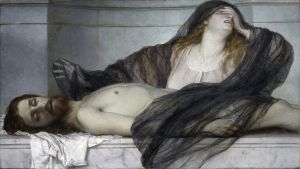
The Penitent Magdalene
A hand-painted replica of Titian’s masterpiece The Penitent Magdalene, meticulously crafted by professional artists to capture the true essence of the original. Each piece is created with museum-quality canvas and rare mineral pigments, carefully painted by experienced artists with delicate brushstrokes and rich, layered colors to perfectly recreate the texture of the original artwork. Unlike machine-printed reproductions, this hand-painted version brings the painting to life, infused with the artist’s emotions and skill in every stroke. Whether for personal collection or home decoration, it instantly elevates the artistic atmosphere of any space.
"The Penitent Magdalene" is a renowned painting by the Italian Renaissance master Titian, created around 1531. The artwork is celebrated for its emotional depth and masterful use of color and light, which are hallmarks of Titian's style. This painting is one of several works by Titian that depict Mary Magdalene, a significant figure in Christian tradition known for her repentance and devotion to Jesus Christ.
In "The Penitent Magdalene," Titian portrays Mary Magdalene in a moment of deep contemplation and sorrow. She is depicted with long, flowing hair, which was a common attribute in representations of the Magdalene, symbolizing her former life of sin and her subsequent repentance. Her hair cascades over her shoulders and partially covers her body, adding to the painting's dramatic and emotional intensity.
Mary Magdalene is shown in a secluded, rocky landscape, which enhances the sense of her isolation and penitence. She gazes upwards, her eyes filled with tears, as she clutches a piece of cloth to her chest. This gesture, combined with her upward gaze, suggests her appeal to divine mercy and forgiveness. The background of the painting is relatively dark, which serves to highlight the figure of Mary Magdalene and draw the viewer's attention to her expressive face and hands.
Titian's use of color in "The Penitent Magdalene" is particularly noteworthy. He employs a rich palette of warm tones to create a sense of depth and volume. The contrast between the dark background and the illuminated figure of Mary Magdalene enhances the dramatic effect of the painting. Titian's skillful handling of light and shadow, known as chiaroscuro, adds to the three-dimensional quality of the figure and creates a sense of realism and immediacy.
The painting is also significant for its portrayal of Mary Magdalene as a figure of both physical beauty and spiritual depth. Titian's depiction emphasizes her humanity and vulnerability, making her a relatable and sympathetic figure. This approach reflects the Renaissance interest in the human experience and the exploration of complex emotional states.
"The Penitent Magdalene" is housed in the Palazzo Pitti in Florence, Italy, where it continues to be admired by art enthusiasts and scholars alike. The painting is an excellent example of Titian's ability to convey profound emotion and his mastery of the techniques that defined the Venetian school of painting.
Overall, "The Penitent Magdalene" by Titian is a powerful and moving depiction of repentance and redemption, showcasing the artist's exceptional talent and his deep understanding of human emotion. The painting remains an important work in the history of art, admired for its beauty, technical skill, and emotional resonance.

















